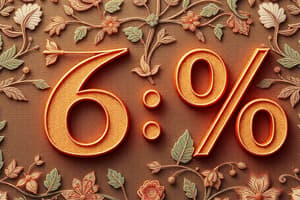Podcast
Questions and Answers
What is the percentage increase if a value goes from 80 to 100?
What is the percentage increase if a value goes from 80 to 100?
- 20% (correct)
- 30%
- 15%
- 25%
If you have 8 parts out of 12 parts, what is the percentage of the number?
If you have 8 parts out of 12 parts, what is the percentage of the number?
- 50%
- 75%
- 66.67% (correct)
- 62.5%
What is the percentage decrease if a value goes from 50 to 40?
What is the percentage decrease if a value goes from 50 to 40?
- -10% (correct)
- -15%
- -20%
- -25%
A value increased by 30% and then decreased by 20%. What is the overall change in percentage?
A value increased by 30% and then decreased by 20%. What is the overall change in percentage?
If the price of an item decreases by 25% and then increases by 30%, what is the net change in percentage?
If the price of an item decreases by 25% and then increases by 30%, what is the net change in percentage?
Flashcards are hidden until you start studying
Study Notes
Sure! Here's a detailed, factual article about the topic "percentage" focusing on the subtopics: calculating percentages, percentage increase, percentage of a number, and percentage decrease.
Percentage
A percentage is a way of expressing a fraction or ratio of any value as a number out of 100. It is often used to express a portion of a value relative to the whole.
Calculating Percentages
Calculating percentages involves three steps:
- Find the total or the whole.
- Find the part that you want to express as a percentage.
- Divide the part by the whole and multiply the result by 100.
For example, if you have a total of 100 apples and you want to find the percentage of apples that are red, you can follow these steps:
- Identify the total number of apples, 100.
- Count the number of red apples, let's say there are 60 red apples.
- Divide the number of red apples (60) by the total number of apples (100) to find the ratio: 60/100 = 0.6.
- Multiply this ratio by 100 to find the percentage: 0.6 * 100 = 60%.
The percentage of red apples is 60%.
Percentage Increase
Percentage increase is the change in a value divided by the original value, expressed as a percentage. To calculate percentage increase, follow these steps:
- Determine the difference between the new value and the old value.
- Divide the difference by the original value.
- Multiply the result by 100.
For example, if the price of a book increases from $20 to $24, the percentage increase is:
- $24 - $20 = $4.
- $4 / $20 = 0.2.
- 0.2 * 100 = 20%.
The percentage increase is 20%.
Percentage of a Number
To find the percentage of a number, you can use the following formula:
Percentage of a number = Number of parts / Total number of parts * 100
For example, if you have 5 parts out of 10 parts, the percentage of a number is:
5 / 10 * 100 = 50%
The percentage of 5 is 50%.
Percentage Decrease
Percentage decrease is the opposite of percentage increase. It is the difference in the value divided by the original value, expressed as a percentage. To calculate percentage decrease, follow these steps:
- Determine the difference between the new value and the old value.
- Divide the difference by the original value.
- Multiply the result by -100.
For example, if the price of a book decreases from $24 to $20, the percentage decrease is:
- $20 - $24 = -$4.
- -$4 / $24 = -0.166666667.
- -0.166666667 * -100 = 16.666666667%.
The percentage decrease is approximately 16.67%.
I hope this article provides a detailed explanation of the topic "percentage" and its subtopics: calculating percentages, percentage increase, percentage of a number, and percentage decrease. Let me know if you have any questions!
Studying That Suits You
Use AI to generate personalized quizzes and flashcards to suit your learning preferences.




